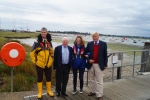Environment Agency - Bathing Water Classifications 2022
The Department for Environment, Food and Rural Affairs (Defra) have today, 19 January 2022, published the classifications for bathing water quality at beaches and inland waters in England. 99% of bathing waters have passed water quality standards.
Over the summer, Environment Agency officers have been out sampling at over 400 designated bathing waters to build-up a clear picture of bathing water quality in England. This helps people to make an informed choice about where they want to swim.
Bathing waters are monitored for sources of pollution known to be a risk to bathers’ health, with up to 20 samples taken from each site during the bathing season. Each sample is tested for bacteria, specifically E coli and intestinal enterococci.
Bathing waters are classified as:
- Excellent – the highest, cleanest class
- Good – generally good water quality
- Sufficient – the water meets minimum standards
- Poor – the water has not met the minimum standards. Work is planned to improve bathing waters not yet reaching Sufficient
The National results show that for the 2021 bathing season 94.7% of beaches and inland waters gained an ‘Excellent’ or ‘Good’ rating, while 4.3% achieved the minimum ‘Sufficient’ rating. This compares with 98.3% passing the required standards in 2019, and is the highest number since new standards were introduced in 2015.
The 2021 bathing water classifications for the bathing waters in your Chichester constituency are:

There was no 2020 classification due to covid restrictions
We have been monitoring bathing water sites since the 1990s, and in this time there have been significant improvements. While progress has been made, there is still much more to be done to ensure cleaner and healthier waters for people to enjoy. We are clear that more needs to be done on the part of water companies, and we are taking robust action to support regulators, businesses, farmers and councils to help clean up our waters.
Since 2015 we have required water companies to install Event Duration Monitors at bathing water sites. This captures data on the frequency and duration of storm overflow discharges, with all the data published online so the public can see what is happening in their local area. More than 12,000 of England’s 15,000 storm overflows now have these monitors, and the remaining 3,000 will have them by end of next year.
Knowing more about water quality helps people make informed decisions on when and where to swim. Our Swimfo website provides detailed information on each of the 400+ bathing waters in England, and notifies bathers when Pollution Risk Warnings have been issued.


